Submitted:
30 August 2023
Posted:
31 August 2023
You are already at the latest version
Abstract
Keywords:
1. Introduction
2. Materials and Methods
2.1. Study area
2.2. Vegetation analysis of the cattle-grazed wood-pasture
2.3. Spatial pattern and dynamics of the wood-pasture use by cattle
2.3.1. Cattle itineraries on the wood-pasture
2.3.2. Temporary cattle groupings and livestock temporal impact on the wood-pasture
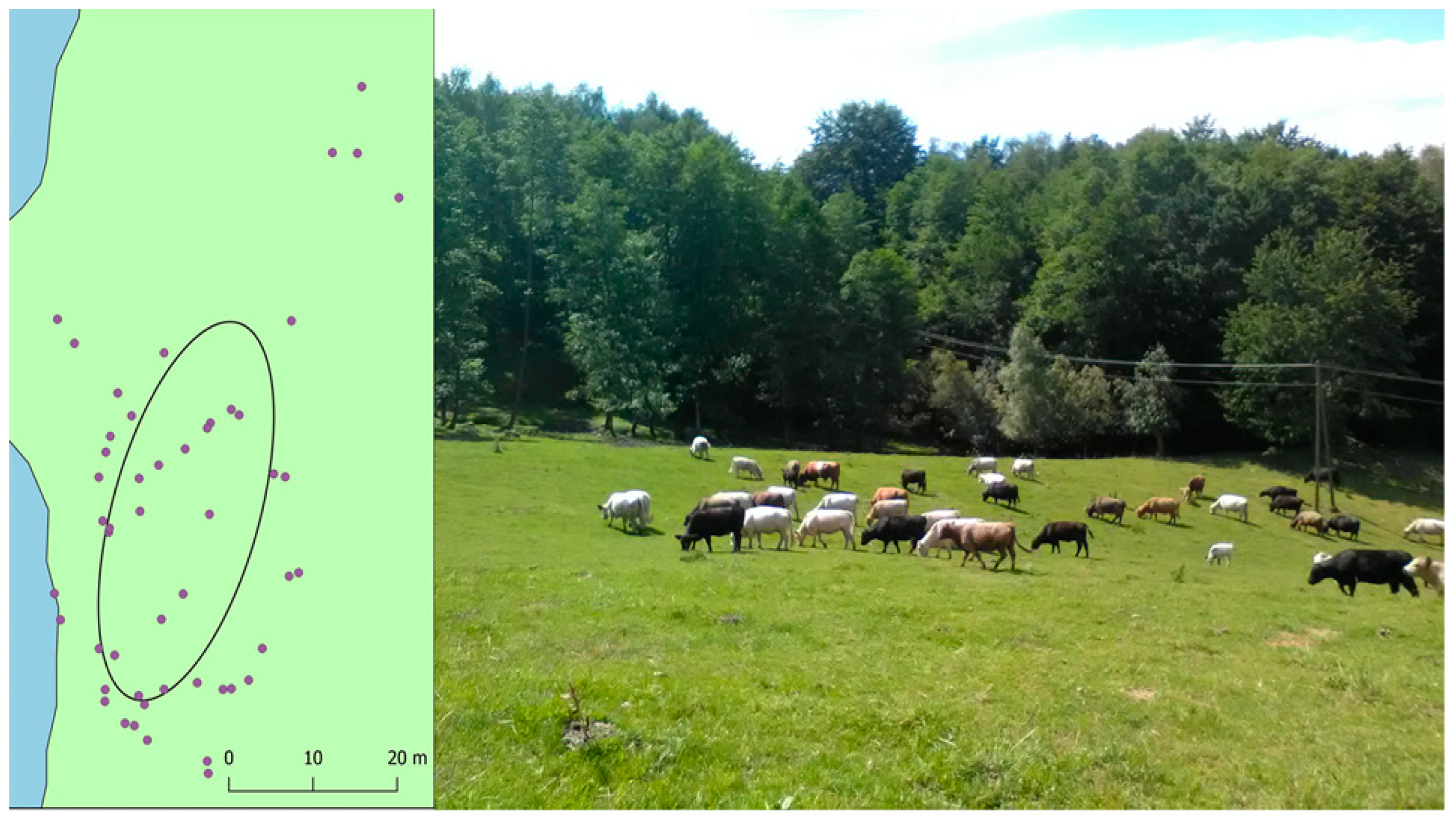
2.3.4. Cattle feeding pattern on arboreal forages
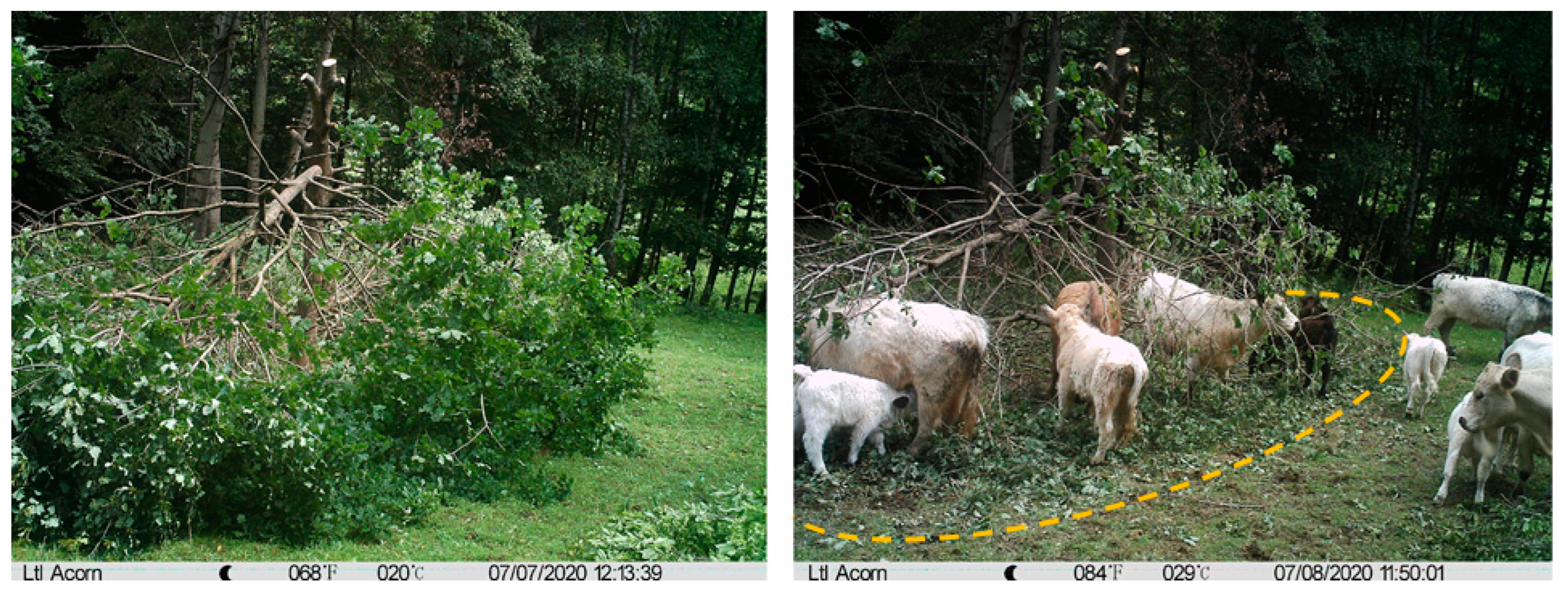
2.4. Nutritional characteristics of the wood-pasture fodder
3. Results
3.1. Vegetation structure of the wood-pasture
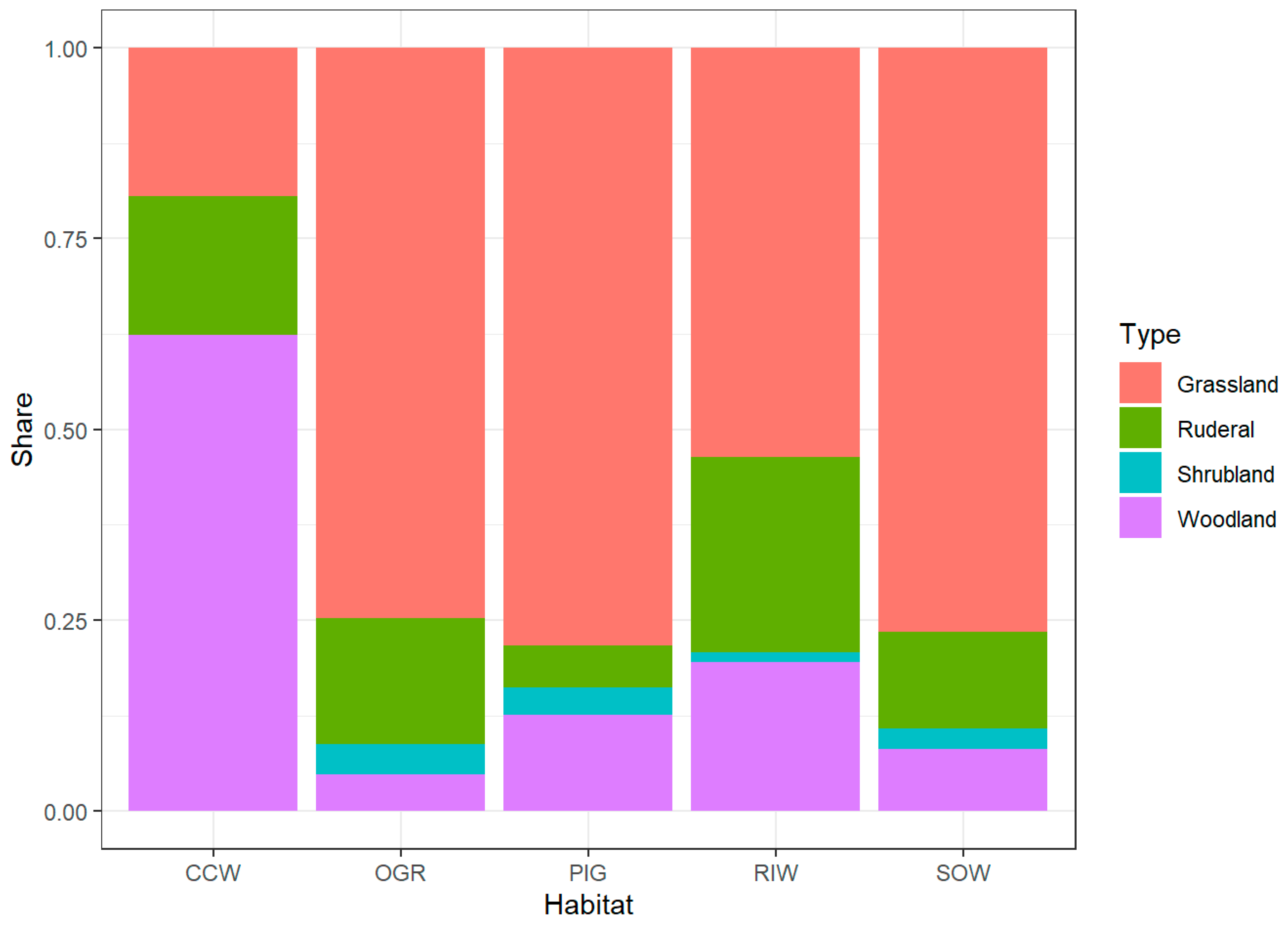
3.2. Spatiotemporal use of the wood-pasture by cattle
3.2.1. Habitats’ preferences of the tracked cows and temporary cattle groupings
3.2.2. Livestock temporal impact on herbaceous and arboreal forages
3.3. Comparison of nutritional composition of herbaceous and arboreal forages
4. Discussion
5. Conclusions
Supplementary Materials
Author Contributions
Funding
Data Availability Statement
Acknowledgments
Conflicts of Interest
References
- EC (European Commission). A European Green Deal: Striving to be the first climate-neutral continent. 2021. https://ec.europa.eu/info/strategy/priorities-2019-2024/european-green-deal/delivering-european-green-deal_en.
- Navarro, L.M.; Pereira, H.M. Rewilding abandoned landscapes in Europe. Ecosystems 2012, 15, 900–912. [Google Scholar] [CrossRef]
- MacDonald, D.; Crabtree, J.R.; Wiesinger, G.; Dax, T.; Stamou, N.; Fleury, P.; Gutierrez Lazpita, J.; Gibon, A. Agricultural abandonment in mountain areas of Europe: Environmental consequences and policy response. Journal of Environmental Management 2000, 59, 47–69. [Google Scholar] [CrossRef]
- Brambilla, M.; Gustin, M.; Vitulano, S.; Falco, R.; Bergero, V.; Negri, I.; Bogliani, G.; Celada, C. Sixty years of habitat decline: Impact of land-cover changes in northern Italy on the decreasing ortolan bunting Emberiza hortulana. Regional Environmental Change 2017, 17, 323–333. [Google Scholar] [CrossRef]
- Biró, M.; Molnár, Z.; Öllerer, K.; Lengyel, A.; Ulicsni, V.; Szabados, K.; Kiš, A.; Perić, R.; Demeter, L.; Babai, D. Conservation and herding co-benefit from traditional extensive wetland grazing. Agriculture, Ecosystems & Environment 2020, 300, 106983. [Google Scholar] [CrossRef]
- Lomba, A.; Moreira, F.; Klimek, S.; Jongman, R.H.G.; Sullivan, C.; Moran, J.; Poux, X.; Honrado, J.P.; Pinto-Correia, T.; Plieninger, T.; McCracken, D.I. Back to the future: Rethinking socioecological systems underlying high nature value farmlands. Frontiers in Ecology and the Environment 2019, 18, 36–42. [Google Scholar] [CrossRef]
- Liu, J.; Dietz, T.; Carpenter, S.R.; Alberti, M.; Folke, C.; Moran, E.; Pell, A.N.; Deadman, P.; Kratz, T.; Lubchenco, J.; Taylor, W.W.; et al. Complexity of Coupled Human and Natural Systems. Science 2007, 317, 1513–1516. [Google Scholar] [CrossRef]
- Kirwan, M.C. Ecological embeddedness: An interrogation and refinement of the concept within the context of alternative food networks in the UK. Journal of Rural Studies 2011, 27, 322–330. [Google Scholar] [CrossRef]
- Rotherham, I.D. Cultural landscapes and problems associated with the loss of tradition and custom: An introduction and overview. In Cultural Severance and the Environment. Environmental History; Rotherham, I., Ed.; Springer: Dordrecht, 2013; Volume 2. [Google Scholar] [CrossRef]
- Vos, W.; Meekes, H. Trends in European cultural landscape development: Perspectives for a sustainable future. Landscape and Urban Planning 1999, 46, 3–14. [Google Scholar] [CrossRef]
- Bobiec, A.; Paderewski, J.; Gajdek, A. Urbanisation and globalised environmental discourse do not help to protect the bio-cultural legacy of rural landscapes. Landscape and Urban Planning 2021, 208, 104038. [Google Scholar] [CrossRef]
- Aswani, S.; Lemahieu, A.; Sauer, W.H.H. Global trends of local ecological knowledge and future implications. PLoS ONE 2018, 13, e0195440. [Google Scholar] [CrossRef]
- Barthel, S.; Crumley, C.; Svedin, U. Bio-cultural refugia—Safeguarding diversity of practices for food security and biodiversity. Global Environmental Change 2013, 23, 1142–1152. [Google Scholar] [CrossRef]
- Pérez-Caselles, C.; Brugarolas, M.; Martínez-Carrasco, L. Traditional varieties for local markets: A sustainable proposal for agricultural SMEs. Sustainability 2020, 12, 4517. [Google Scholar] [CrossRef]
- Tüxen, R. Die heutige potentielle natürliche vegetation als gegenstand der vegetationskartierung. Angewandte Pflanzensoziologie 1956, 13, 5–55. [Google Scholar]
- Matuszkewicz, W. Przewodnik do oznaczania zbiorowisk roślinnych Polski. [The guide to identification of plant communities of Poland] Vademecum Geobotanicum 3, Wyd. Nauk. PWN, Warszawa, 2008. [in Polish].
- Matuszkiewicz, J. Potential natural vegetation of Poland. Institute of Geography and Spatial Organization, Polish Academy of Sciences (IGSO PAS), Warsaw, 2008. https://www.igipz.pan.pl/potential-vegetation-dge.html.
- Zarzycki, J.; Korzeniak, J.; Perzanowska, J. Impact of land use changes on the diversity and conservation status of the vegetation of mountain grasslands (Polish Carpathians). Land 2022, 11. [Google Scholar] [CrossRef]
- Affek, A.N.; Wolski, J.; Zachwatowicz, M.; Ostafin, K.; Radeloff, V.C. Effects of post-WWII forced displacements on long-term landscape dynamics in the Polish Carpathians. Landscape and Urban Planning 2021, 214, 104164. [Google Scholar] [CrossRef]
- Jandl, R.; Spathelf, P.; Bolte, A.; Prescott, C.E. Forest adaptation to climate change—Is non-management an option? Annals of Forest Science 2019, 76, 48. [Google Scholar] [CrossRef]
- Olff, H.; Vera, F.; Bokdam, J.; Bakker, E.; Gleichman, J.; De Maeyer, K.; Smit, R. Associational resistance of plants to herbivory may lead to shifting mosaics in grazed woodlands. Plant Biology 1999, 1, 127–137. [Google Scholar] [CrossRef]
- Öllerer, K. The ground vegetation management of wood-pastures in Romania – Insights in the past for conservation management in the future. Applied Ecology and Environmental Research 2014, 12, 549–562. [Google Scholar] [CrossRef]
- Bobiec, A.; Podlaski, R.; Ortyl, B.; Korol, M.; Havryliuk, S.; Öllerer, K.; Ziobro, J.M.; Pilch, K.; Dychkevych, V.; Dudek, T.; Mázsa, K.; Varga, A.; Angelstam, P. Top-down segregated policies undermine the maintenance of traditional wooded landscapes: Evidence from oaks at the European Union’s eastern border. Landscape and Urban Planning 2019, 189, 247–259. [Google Scholar] [CrossRef]
- Hector, A.; Hautier, Y.; Saner, P.; Wacker, L.; Bagchi, R.; Joshi, J.; Scherer-Lorenzen, M.; Spehn, E.M.; Bazeley-White, E.; Weilenmann, M.; Loreau, M.; et al. General stabilizing effects of plant diversity on grassland productivity through population asynchrony and overyielding. Ecology 2010, 91, 2213–2220. [Google Scholar] [CrossRef]
- Muraina, T.O.; Xu, C.; Yu, Q.; Yang, Y.; Jing, M.; Jia, X.; Jaman, M.S.; Dam, Q.; Knapp, A.K.; Collins, S.L.; Smith, M.D.; et al. Species asynchrony stabilises productivity under extreme drought across Northern China grasslands. Journal of Ecology 2021, 109, 1665–1675. [Google Scholar] [CrossRef]
- Gámez-Virués, S.; Perović, D.J.; Gossner, M.M.; Börschig, C.; Blüthgen, N.; de Jong, H.; Simons, N.K.; Klein, A.-M.; Krauss, J.; Westphal, C.; et al. Landscape simplification filters species traits and drives biotic homogenization. Nature Communications 2015, 6, 8568. [Google Scholar] [CrossRef] [PubMed]
- Dass, P.; Houlton, B.Z.; Wang, Y.; Warlind, D. Grasslands may be more reliable carbon sinks than forests in California. Environmental Research Letters 2018, 13, 074027. [Google Scholar] [CrossRef]
- Dyderski, M.K.; Paź, S.; Frelich, L.E.; Jagodziński, A.M. How much does climate change threaten European forest tree species distributions? Global Change Biology 2018, 24, 1150–1163. [Google Scholar] [CrossRef] [PubMed]
- Horak, J.; Vodka, S.; Kout, J.; Halda, J.P.; Bogusch, P.; Pech, P. Biodiversity of most dead wood-dependent organisms in thermophilic temperate oak woodlands thrives on diversity of open landscape structures. Forest Ecology and Management 2014, 315, 80–85. [Google Scholar] [CrossRef]
- Miklín, J.; Čížek, L. Erasing a European biodiversity hot-spot: Open woodlands, veteran trees and mature forests succumb to forestry intensification, succession, and logging in a UNESCO Biosphere Reserve. Journal for Nature Conservation 2014, 22, 35–41. [Google Scholar] [CrossRef]
- Bruun, H.H.; Fritzbøger, B. The past impact of livestock husbandry on dispersal of plant seeds in the landscape of Denmark. AMBIO: A Journal of the Human Environment 2002, 31, 425–431. [Google Scholar] [CrossRef]
- Bergmeier, E.; Petermann, J.; Schröder, E. Geobotanical survey of wood-pasture habitats in Europe: Diversity, threats and conservation. Biodiversity and Conservation 2010, 19, 2995–3014. [Google Scholar] [CrossRef]
- Coutinho, P.; Simões, M.; Pereira, C.; Paiva, T. Sustainable local exploitation and innovation on meat products based on the autochthonous bovine breed Jarmelista. Sustainability 2021, 13, 2515. [Google Scholar] [CrossRef]
- Wolański, P.; Bobiec, A.; Ortyl, B.; Makuch-Pietraś, I.; Czarnota, P.; Ziobro, J.; Korol, M.; Havryliuk, S.; Paderewski, J.; Kirby, K. The importance of livestock grazing at woodland-grassland interface in the conservation of rich oakwood plant communities in temperate Europe. Biodiversity and Conservation 2021, 30, 741–760. [Google Scholar] [CrossRef]
- Braun-Blanquet, J.; Pavillard, J. Vocabulaire de sociologie végétale. Roumégous et Déhan, Montpellier, 1925.
- Wang, B.; Shi, W.; Miao, Z. Confidence analysis of standard deviational ellipse and its extension into higher dimensional euclidean space. PLoS ONE 2015, 10, e0118537. [Google Scholar] [CrossRef] [PubMed]
- Marascuilo, L.A. Large-sample multiple comparisons. Psychological Bulletin 1966, 65, 280–290. [Google Scholar] [CrossRef] [PubMed]
- AOAC. Official Methods of Analysis of Association of Official Analytical Chemists (AOAC). 2020. http://www.eoma.aoac.org/.
- Zaguła, G.; Zardzewiały, M.; Saletnik, B.; Bajcar, M.; Czernicka, M.; Grabek-Lejko, D.; Kasprzyk, I.; Puchalski, C. Effects of fertiliser use and pre-sowing seed stimulation with a magnetic field on the mineral content and yield of three varieties of sugar beet roots. Journal of Elementology 2017, 22, 1401–1414. [Google Scholar] [CrossRef]
- Jaworski, A.; Kołodziej, Z.; Porada, K. Structure and dynamics of stands of primeval character in selected areas of the Bieszczady National Park. Journal of Forest Science 2002, 48, 185–201. https://www.agriculturejournals.cz/publicFiles/285822.pdf. [CrossRef]
- Spracklen, B.D.; Spracklen, D.V. Old-Growth Forest Disturbance in the Ukrainian Carpathians. Forests 2020, 11, 151. [Google Scholar] [CrossRef]
- Bobiec, A.; Reif, A.; Öllerer, K. Seeing the oakscape beyond the forest: A landscape approach to the oak regeneration in Europe. Landscape Ecology 2018, 33, 513–528. [Google Scholar] [CrossRef]
- Peterken, G.F.; Game, M. Historical factors affecting the number and distribution of vascular plant species in the woodlands of Central Lincolnshire. Journal of Ecology 1984, 72, 155–182. [Google Scholar] [CrossRef]
- Dzwonko, Z.; Gawroński, S. The role of woodland fragments, soil types, and dominant species in secondary succession on the western Carpathian foothills. Vegetatio 1994, 111, 149–160. [Google Scholar] [CrossRef]
- Arcanum-maps. Europe in the XIX. Century. 2022. https://tinyurl.com/arcanummaps.
- Bobiec, A.; Kuijper, D.P.J.; Niklasson, M.; Romankiewicz, A.; Solecka, K. Oak (Quercus robur L.) regeneration in early successional woodlands grazed by wild ungulates in the absence of livestock. Forest Management and Ecology 2011, 262, 780–790. [Google Scholar] [CrossRef]
- Kowalczyk, R.; Kamiński, T.; Borowik, T. Do large herbivores maintain open habitats in temperate forests? Forest Ecology and Management 2021, 494, 119310. [Google Scholar] [CrossRef]
- Vandermeulen, S.; Ramírez-Restrepo, C.A.; Beckers, Y.; Claessens, H.; Bindelle, J. Agroforestry for ruminants: A review of trees and shrubs as fodder in silvopastoral temperate and tropical production systems. Animal Production Science 2018, 58, 767–777. [Google Scholar] [CrossRef]
- Slotte, H. Harvesting of leaf-hay shaped the Swedish landscape. Landscape Ecology 2001, 16, 691–702. [Google Scholar] [CrossRef]
- Treydte, A.C.; Heitkönig, I.M.A.; Prins, H.H.T.; Ludwig, F. Trees improve grass quality for herbivores in African savannas. Perspectives in Plant Ecology, Evolution and Systematics 2007, 8, 197–205. [Google Scholar] [CrossRef]
- Van Laer, E.; Tuyttens, F.A.M.; Ampe, B.; Sonck, B.; Moons, C.P.H.; Vandaele, L. Effect of summer conditions and shade on the production and metabolism of Holstein dairy cows on pasture in temperate climate. Animal 2015, 9, 1547–1558. [Google Scholar] [CrossRef] [PubMed]
- Moore, K.M.; Barry, T.N.; Cameron, P.N.; Lopez-Villalobos, N.; Cameron, D.J. Willow (Salix sp.) as a supplement for grazing cattle under drought conditions. Animal Feed Science and Technology 2003, 104, 1–11. [Google Scholar] [CrossRef]
- Papanastasis, V.P.; Yiakoulaki, M.D.; Decandia, M.; Dini-Papanastasi, O. Integrating woody species into livestock feeding in the Mediterranean areas of Europe. Animal Feed Science and Technology 2008, 140, 1–17. [Google Scholar] [CrossRef]
- Gowda, N.K.S.; Ramana, J.V.; Prasad, C.S.; Singh, K. Micronutrient content of certain tropical conventional and unconventional feed resources of southern India. Tropical Animal Health and Production 2004, 36, 77–94. [Google Scholar] [CrossRef]
- Bakshi, M.; Wadhwa, M. Comparative nutritional evaluation of forest tree leaves and wild grasses of semi hilly arid zone in Punjab. Indian Journal of Animal Sciences 2012, 82. [Google Scholar]
- Tefera, S.; Mlambo, V. Macro and trace elements of 26 browse species growing in semi-arid grazing lands of Eastern Cape, South Africa. African Journal of Range & Forage Science 2017, 34, 209–217. [Google Scholar] [CrossRef]
- Mateos, G.; Fondevila, G.; Cámara, L. Chapter 3: The importance of the fibre fraction of the feed in non-ruminant diets. 2019, pp. 61–83. [CrossRef]
- González-Hernández, M.P.; Karchesy, J.; Starkey, E.E. Research observation: Hydrolyzable and condensed tannins in plants of northwest spain forests. Journal of Range Management 2003, 56, 461–465. [Google Scholar] [CrossRef]
- Provenza, F.D.; Villalba, J.J.; Dziba, L.E.; Atwood, S.B.; Banner, R.E. Linking herbivore experience, varied diets, and plant biochemical diversity. Small Ruminant Research 2003, 49, 257–274. [Google Scholar] [CrossRef]
- Lisonbee, L.D.; Villalba, J.J.; Provenza, F.D.; Hall, J.O. Tannins and self-medication: Implications for sustainable parasite control in herbivores. Behavioural Processes 2009, 82, 184–189. [Google Scholar] [CrossRef]
- Grainger, C.; Clarke, T.; Auldist, M.J.; Beauchemin, K.; McGinn, S.; Waghorn, G.C.; Eckard, R. Potential use of Acacia mearnsii condensed tannins to reduce methane emissions and nitrogen excretion from grazing dairy cows. Canadian Journal of Animal Science 2009, 89, 241–251. [Google Scholar] [CrossRef]
- Altermann, E.; Reilly, K.; Young, W.; Ronimus, R.S.; Muetzel, S. Tailored nanoparticles with the potential to reduce ruminant methane emissions. Frontiers in Microbiology 2022, 13. [Google Scholar] [CrossRef]
- Marie, P.J.; Ammann, P.; Boivin, G.; Rey, C. Mechanisms of action and therapeutic potential of strontium in bone. Calcified Tissue International 2001, 69, 121–129. [Google Scholar] [CrossRef]
- Nielsen, S.P. The biological role of strontium. Bone 2004, 35, 583–588. [Google Scholar] [CrossRef]
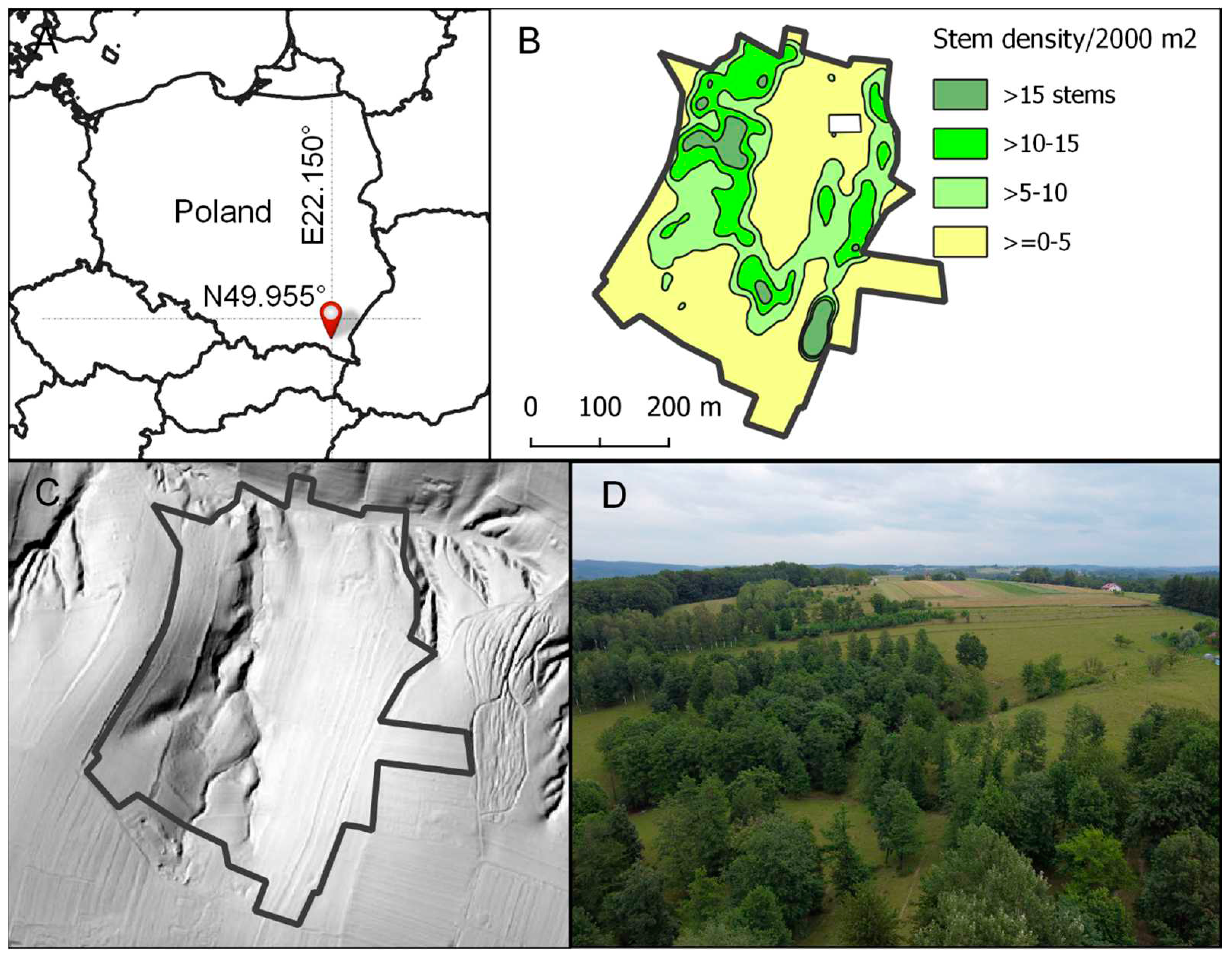
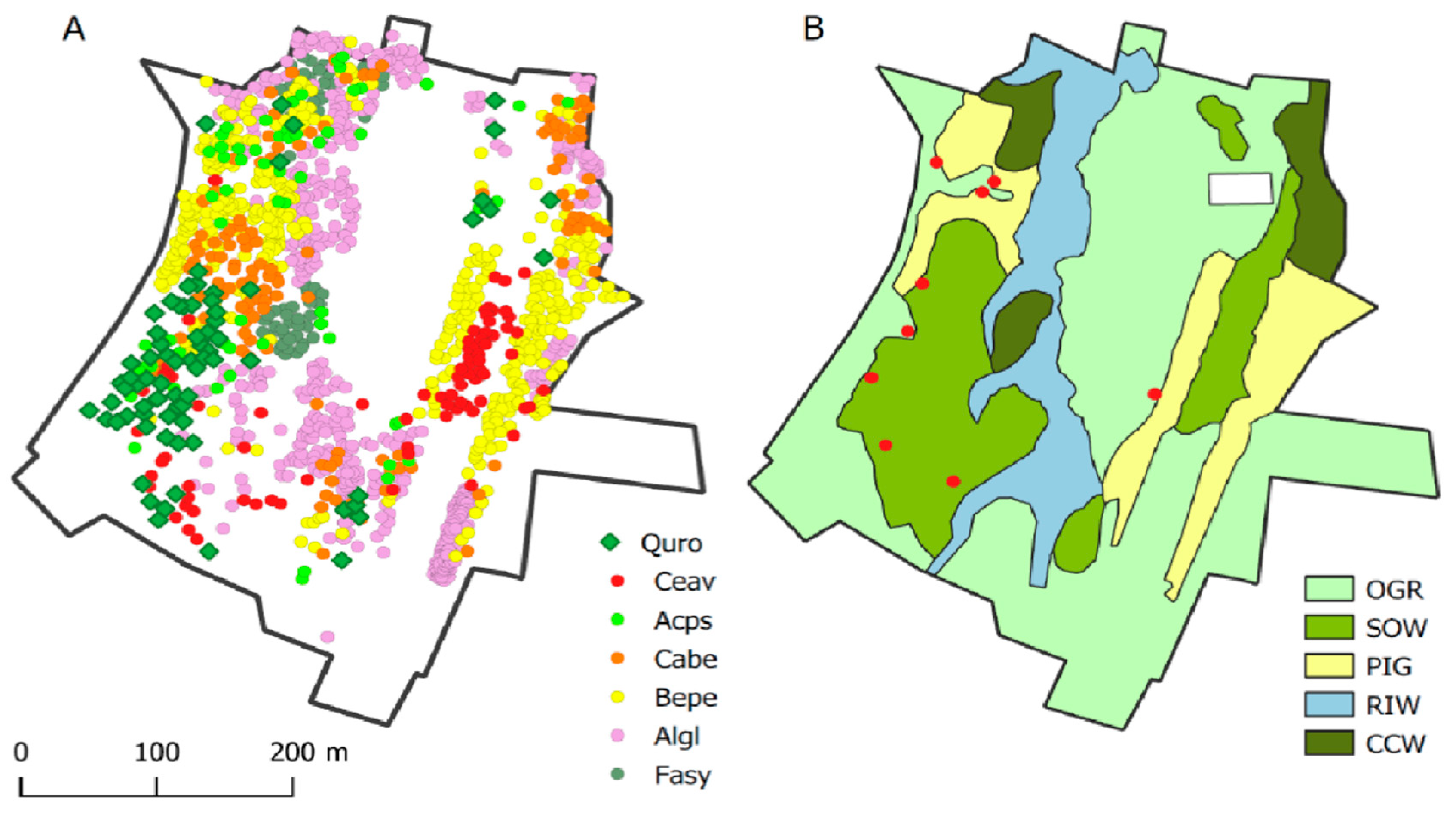
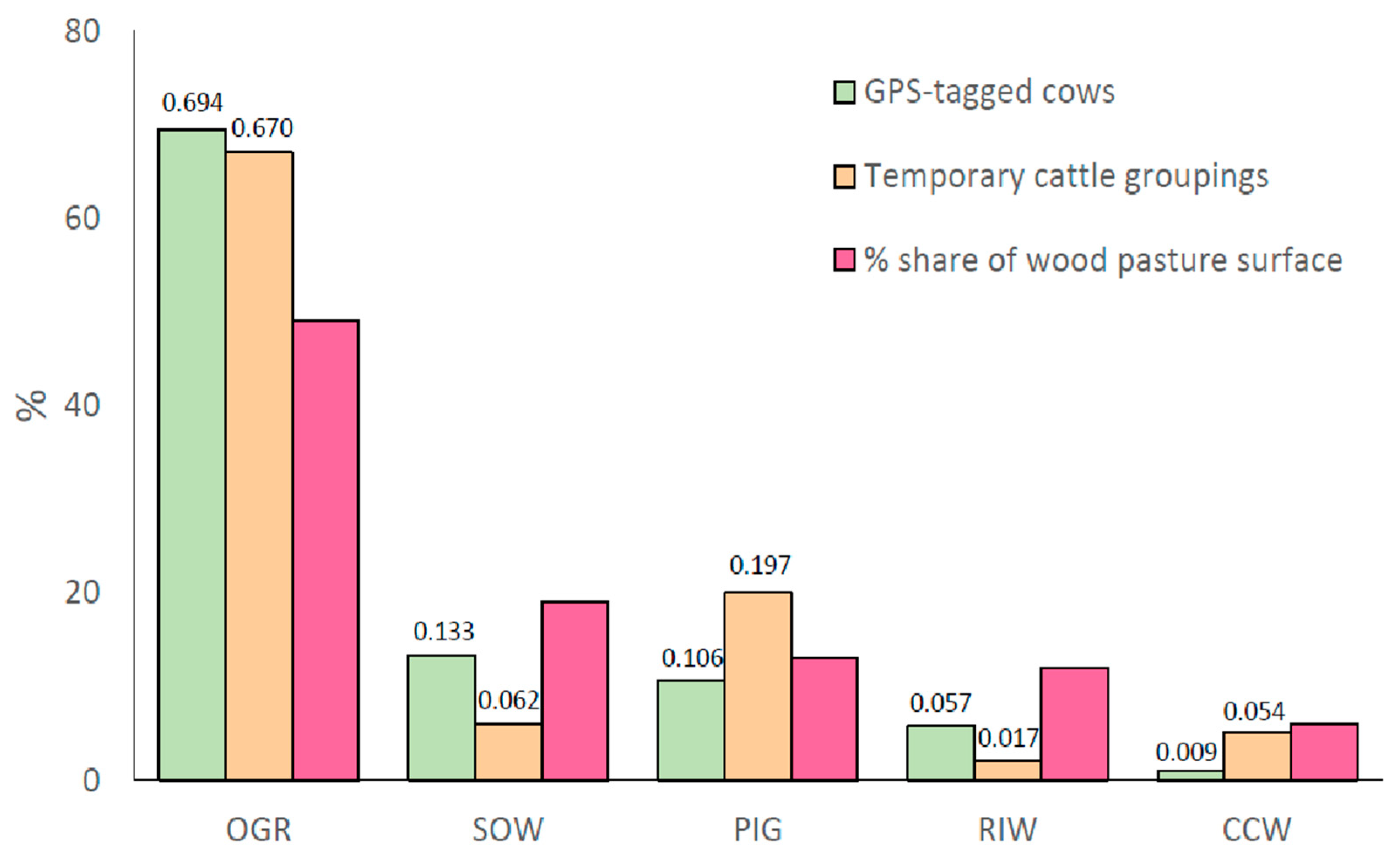
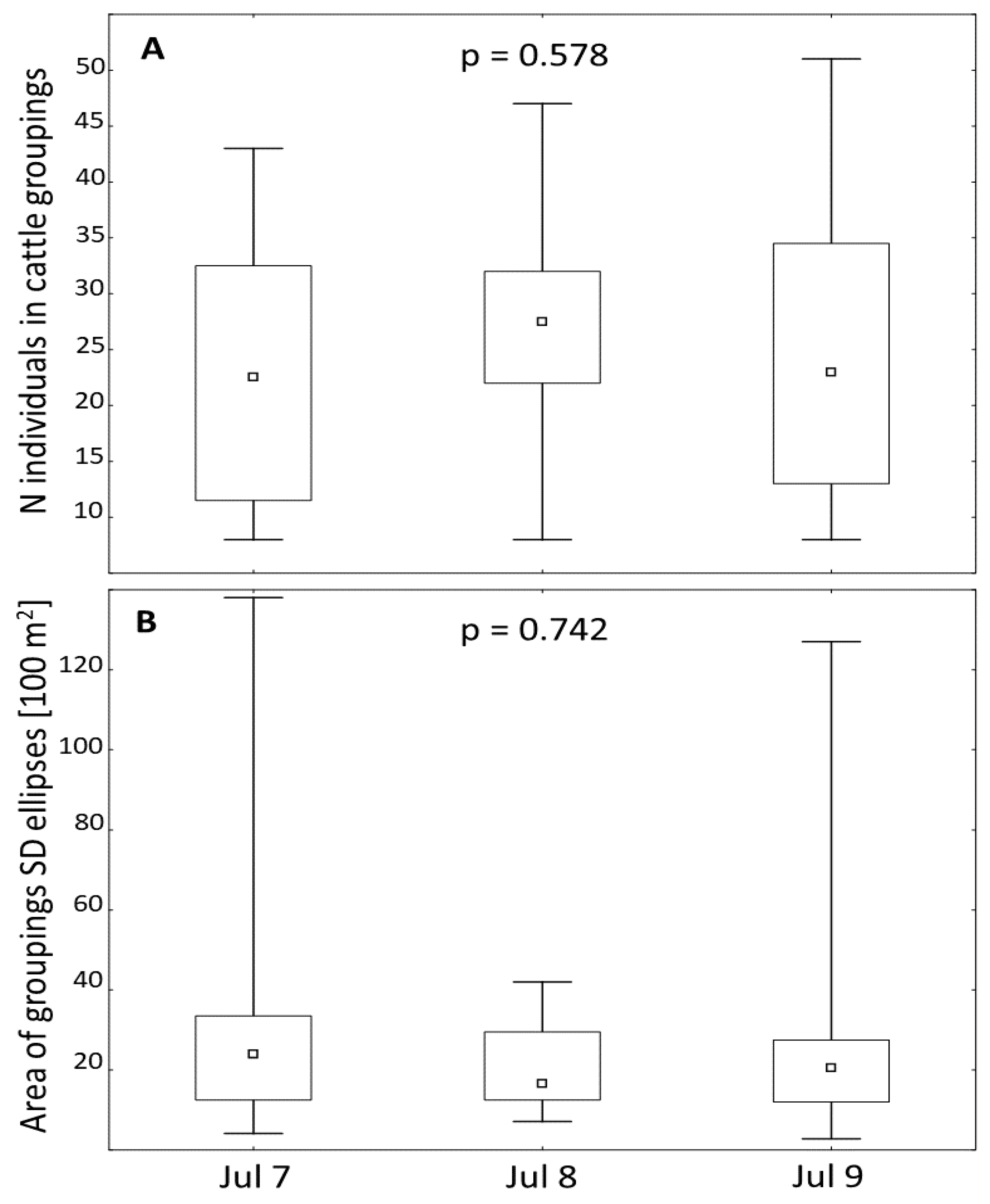
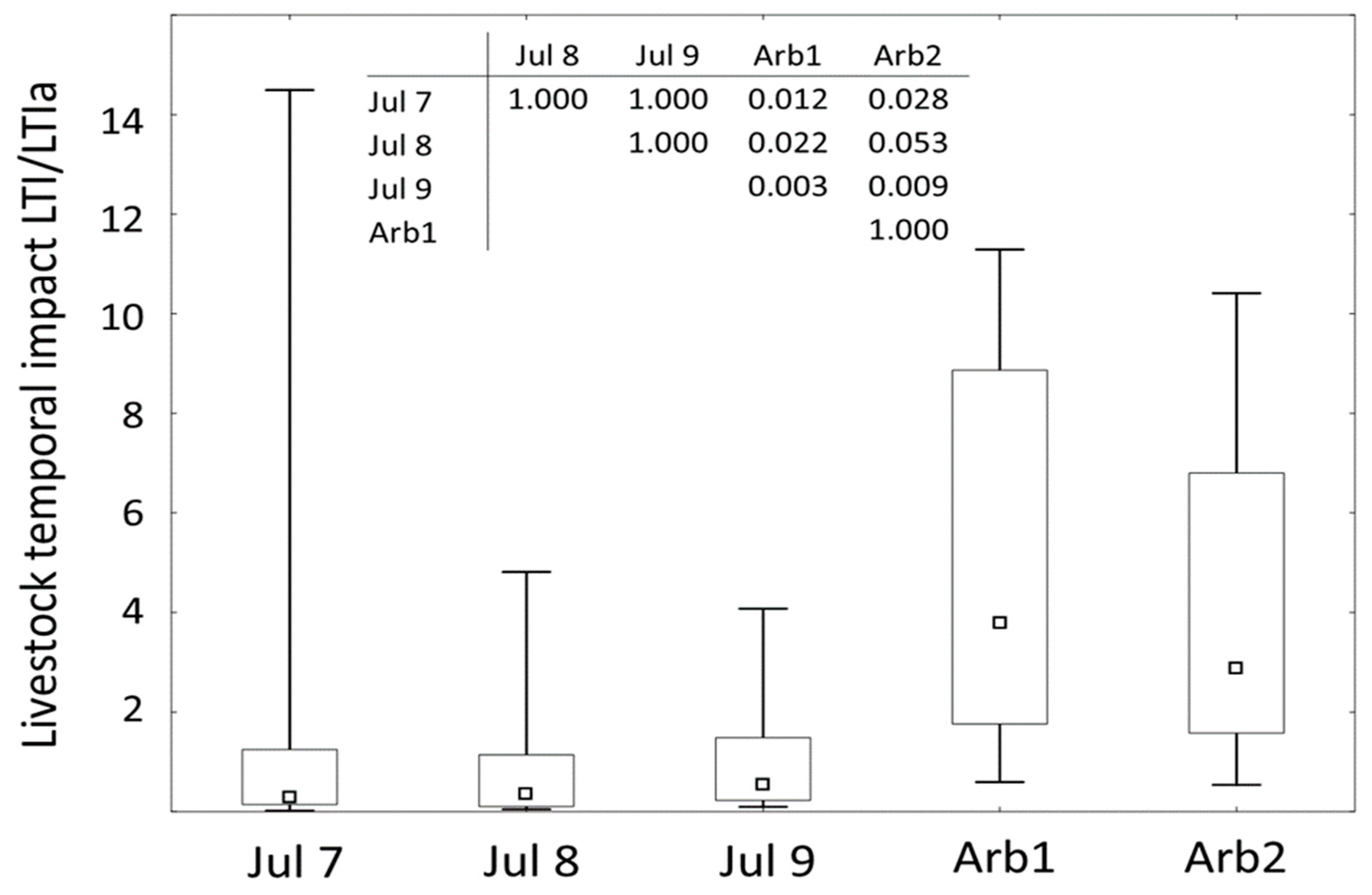
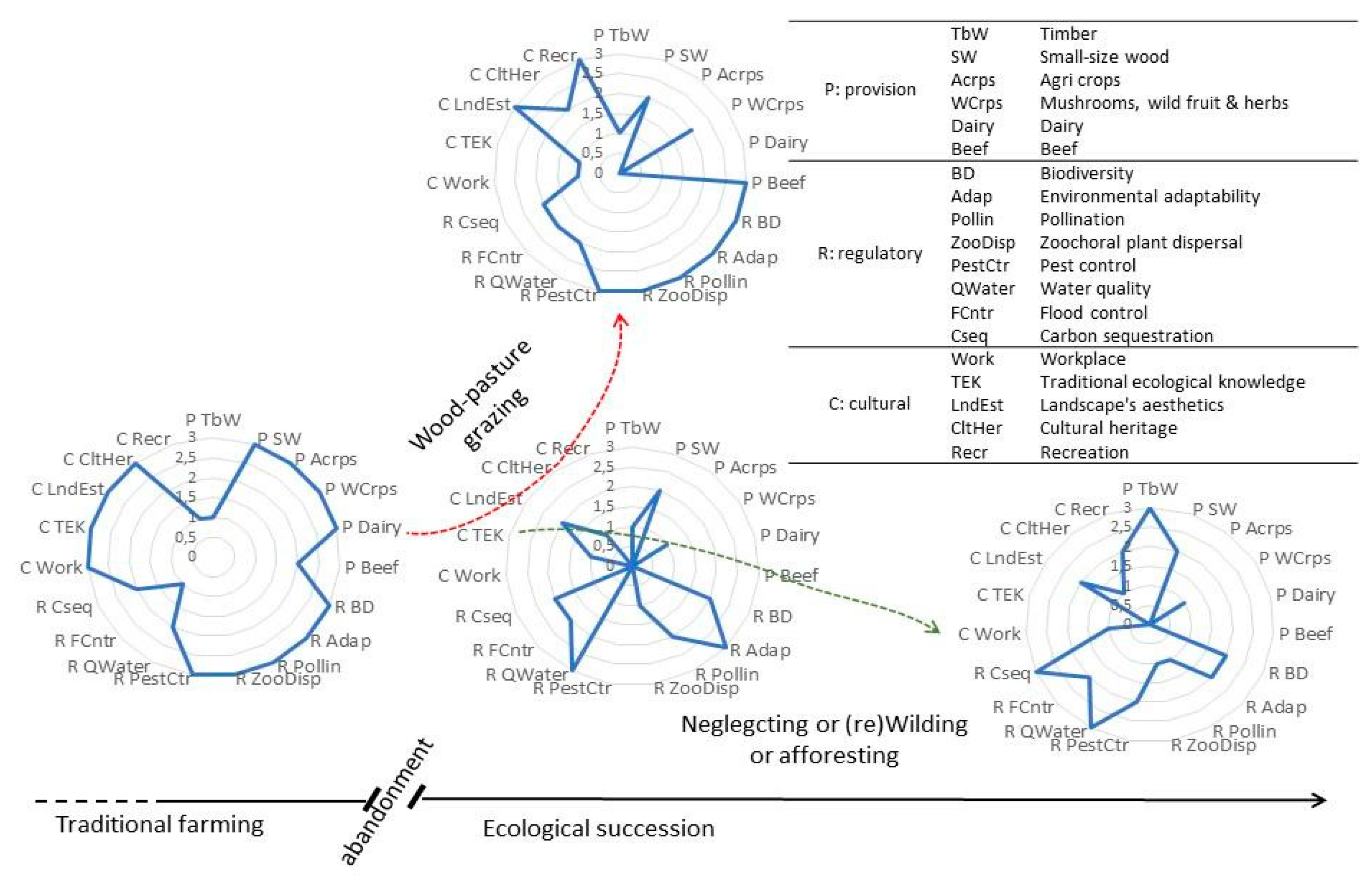
| Species affiliation | CCW | OGR | PIG | RIW | SOW |
| Woodland communities | 48 | 13 | 14 | 16 | 9 |
| Grassland and ruderal communities | 29 | 249 | 93 | 65 | 99 |
| Nutrient | K-W p | Leaves | Twigs | Herbs | Mmin | Mmax | |
|---|---|---|---|---|---|---|---|
| Protein | 0.000 | Herbs | 0.021↑ | 0.023↓ | Bepe.t | Algl.l | |
| Leaves | 0.000↓ | 10.732 | 5.117 | 19.860 | |||
| Fat | 0.000 | Herbs | 0.001↑ | 1.000 | Acps.t | Algl.l | |
| Leaves | 0.000↓ | 2.204 | 0.722 | 6.657 | |||
| Fibre | 0.000 | Herbs | 0.002↓ | 0.210↑ | Ceav.l | Cabe.t | |
| Leaves | 0.000↑ | 33.886 | 16.700 | 45.334 | |||
| Ash | 0.000 | Herbs | 0.092↓ | 0.000↓ | Bepe.t | ||
| Leaves | 0.000↓ | 9.523 | 2.691 | 9.523 | |||
| NFE | 0.000 | Herbs | 0.000↑ | 0.002↑ | Cabe.l | ||
| Leaves | 0.049↓ | 43.784 | 43.784 | 55.512 |
| Element. | K-W p | Leaves | Twigs | Herbs | Mmin | Mmax | |
|---|---|---|---|---|---|---|---|
| Ca | 0.000 | Herbs | 0.000↑ | 0.000↑ | Ca.l | ||
| Leaves | 0.996↓ | 5.482 | 5.482 | 16.630 | |||
| K | 0.000 | Herbs | 0.139↓ | 0.000↓ | Bp.t | Ca.l | |
| Leaves | 0.000↓ | 16.962 | 8.696 | 17.164 | |||
| Mg | 0.000 | Herbs | 0.409↑ | 0.001↓ | Ag.t | Ca.l | |
| Leaves | 0.000↓ | 2.128 | 0.606 | 4.063 | |||
| P | 0.000 | Herbs | 1.000 | 0.000↓ | Ca.t | ||
| Leaves | 0.000↓ | 2.247 | 0.896 | 2.247 | |||
| S | 0.000 | Herbs | 1.000 | 0.000↓ | Ca.t | Ag.l | |
| Leaves | 0.000↓ | 1.634 | 0.430 | 1.753 | |||
| Mn | 0.008 | Herbs | 0.144↑ | 1.000 | Ca.t | Cb.l | |
| Leaves | 0.010↓ | 0.321 | 0.116 | 1.987 | |||
| Fe | 0.066 | Herbs | 0.066↓ | 0.133↓ | Ap.t | ||
| Leaves | 1.000 | 0.175 | 0.050 | 0.175 | |||
| Al | 0.000 | Herbs | 0.194↓ | 0.000↓ | Qr.t | Cb.l | |
| Leaves | 0.003↓ | 0.177 | 0.023 | 0.443 | |||
| Sr | 0.000 | Herbs | 0.008↑ | 0.000↑ | Cb.l | ||
| Leaves | 0.005↑ | 0.020 | 0.020 | 0.043 | |||
| Zn | 0.020 | Herbs | 1.000 | 0.052↑ | Ca.l | Bp.l | |
| Leaves | 0.082↑ | 0.024 | 0.013 | 0.122 |
Disclaimer/Publisher’s Note: The statements, opinions and data contained in all publications are solely those of the individual author(s) and contributor(s) and not of MDPI and/or the editor(s). MDPI and/or the editor(s) disclaim responsibility for any injury to people or property resulting from any ideas, methods, instructions or products referred to in the content. |
© 2023 by the authors. Licensee MDPI, Basel, Switzerland. This article is an open access article distributed under the terms and conditions of the Creative Commons Attribution (CC BY) license (http://creativecommons.org/licenses/by/4.0/).





